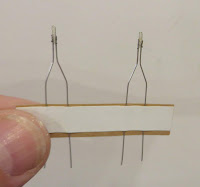At the recent Estes NARAM plant tour, we saw the igniter machine in operation. Somebody mentioned the clear igniter tip was nothing more than corn starch, glue and water.

So, the clear tip is water soluble.
I bent the wire ends over the top lip glass of water and let the clear tip soak for a few minutes.
The softened clear tip came off pretty easily. The bridge wire top loop is delicate. Go easy when knocking off the clear tip.
These two bare wire starters (shown below) got the Fabri-Tac glue and powdered black powder applied.
Two regular clear tip were tested beside two with the clear tip removed. All four starters got the glue and BP treatment.
It was apparent the clear tipped igniters took a moment longer to heat before the black powder treatment would flame.
The igniters with the clear tip removed flamed up much faster than the igniters with the clear tips.
The clear tips slowed up the heating of the bridge wire.
The clear tips slowed up the heating of the bridge wire.
So, there you go! If you add an additional step, the Estes Starters can be further improved.

















































